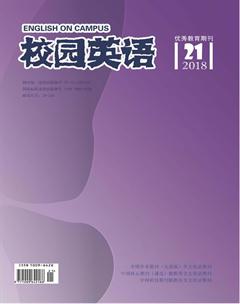The Representation of Middle Constructions in English—Chinese Learner’s Dictionary
【Abstract】Current ECLDs pay scarce attention to learners needs in the representation of middle constructions. The present study is conducted based on cognitive grammar, which focuses on the language acquisition process, aiming at making improvements on the representation of middle constructions in ECLDs.
【Key words】middle construction; cognitive grammar; ECLD
【作者簡介】郑盈,女,汉族,安徽人,上海师范大学附属中学闵行分校,硕士研究生,中学二级,研究方向:外国语言学及应用语言学。
1. Selectional Constraints on Verbs and Adverbials
Only certain subcategories of verbs can form middle constructions. According to Vendlers (1967) aspectual classification of verbs, Fagan (1992) insists that only activity and accomplishment verbs make it. The quality of being volitional is the first condition to be middable. a. The cake cuts easily. b. *The problem notices easily.
Active and passive sentences allow a great variety of adverbs. However, only certain types of adverbs can be added to verbs to form middle constructions. Middle constructions only allow two kinds of adverbs, namely, facility adverbs and event adverbs. Besides, adverbs in middle constructions can not be semantically volitional. a. This little MP3 player plugs in easily. b. Black ink spots dont wash out easily. a. *This little MP3 player plugs in cautiously. b. *Black ink spots dont wash out carefully.
The event adverbs used in middle constructions reflect the condition of patient during or after the event process, and they are non-volitional and agent-neutral. a. This soft bread cuts and chews like gum. b. Our new car handles smoothly.
Vendler (1967: 201) divides verbs into four types according to their aspectual features, namely, activity, accomplishment, achievement and state verbs. a. Activity verbs: drive, play, smoke...b. Accomplishment verbs: assemble, mount, bribe... c. Achievement verbs: recognize, see, notice, acquire... d. State verbs: know, believe, love, own...
The subject of middle construction should be in charge of the event occurrence implied by the middle predicate. The responsibility condition is essential for the middle formation. If the middle formation is impossible, then the subjects should all possess such typical characteristics. We propose that the middle subject should have the feature listed below: (The properties of ) X cause the V-ing (of X) to be Adj. a. The novel sells well / easily. b. The door opens easily.
2. An Adapted Model for Middle Constructions
Based on the information extracted from BNC and the analysis of syntactic features of middle constructions, a new representation of the syntactic patterns of middle verbs in ECLDs are given in this thesis, for instance: read [N+V+Adv] The plans read well. 这计划听起来很不错。translate [N+V+Adv] The items translate easily. 这些条款翻译起来很简单。
Pragmatic information mainly refers to contextual usage and function of certain middle verb. cut v. [N+V+adv](用于描述某物的内在属性)button v. [N+V+adv](用于描述某物的区别性特征)
A representation containing a construction followed by a definition is suggested. Accordingly, the construction can clearly show the usage and the definition can explain the meaning. bribe v. sb bribes easily, they are liable to accept money or valuable things in order to help others do something illegal or dishonest. The Chinese equivalents and translations are also presented. button sth such as a clothes buttons up (at the back)〔某物〕用纽扣(从后背)扣上
A complete representation in ECLDs is shown below:
assemble v. [N+V+Adv] sth such as a piece of furniture assembles easily / rapidly, it can be fitted together in an easy or quick manner(用于描述某物装配时的难易程度等)〔家具等〕(容易或快速)装配;组装:The computer desk assembles easily. 这个电脑桌组装起来很简单。
bribe v. [N+V+ Adv] sb bribes easily, they are liable to accept money or valuable things in order to help others do something illegal or dishonest 〔某人〕(易)受贿或贿赂:The bureaucrats bribe easily. 这个官员很容易贿赂。
write v. [N+V+Adv] sth such as a pen, paper, blackboard etc writes well / smoothly, it is comfortable for someone to use them(用于描述使用某物時的舒适感)〔笔;纸或黑板等〕写起来(舒服的;顺畅的):The new blackboard writes smoothly. 这个新黑板写起来很顺畅。
References:
[1]Steinbach,Markus.(2002).Middle Voice.Amsterdam:John Benjamins.
[2]Stroik,T.(1992).Middles and Movement.Linguistic Inquiry,23,127- 137.

